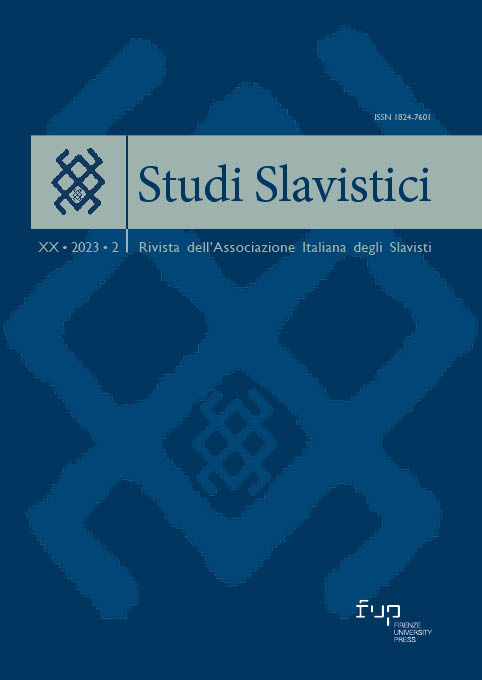Published 2024-01-29
Copyright (c) 2024 Maciej Bandur, Robert Borges

This work is licensed under a Creative Commons Attribution 4.0 International License.
Funding data
-
EEA Grants/Norway Grants
Grant numbers 2020/37/K/HS2/02779
Abstract
New Speakers of minority languages are a special case which gives us a unique glimpse into variation and change. In such cases, language change at an accelerated pace tends to lead to profound changes in the structure of the language. Such developments are observable in Kashubian, a minority Slavic language spoken in East Pomerania. For the purpose of this study, spoken data consisting of responses to video stimuli was collected from a group of Kashubian speakers. Chosen morphophonological developments were analysed, especially repatterning and vowel substitution in nouns and verbs, as well as phonemic mergers and their consequences for the morphological structure.
References
- Bandur 2020: M. Bandur, Pismo jako znak wspólnoty etnicznej. Głos w sprawie polityki języka kaszubskiego, in: A. Kożyczkowska, M. Szczepska-Pustkowska (eds.), Mniejszości etniczne i ich pogranicza. Szkice tożsamościowe, Gdańsk 2020, pp. 326-337.
- Borges 2022: R. Borges, Sourcing Data from Wikipedia for the Study of Language Contact: The Csbwiki, “Academic Journal of Modern Philology”, xviii, 2022, pp. 7-22, <https://doi.org/10.34616/AJMP.2022.18.1>.
- Campbell et al. 2022: L. Campbell, N.H. Lee, E. Okura, S. Simpson, K. Ueki, The Catalogue of Endangered Languages (ElCat), 2022, <https://www.endangeredlanguages.com>.
- Dembińska 2012: M. Dembińska, (Re)Framing Identity Claims: European and State Institutions as Opportunity Windows for Group Reinforcement, “Nations and Nationalism”, xviii, 2012, 3, <https://doi.org/10.1111/j.1469-8129.2011.00540.x>.
- Dukiewicz, Sawicka 1995: L. Dukiewicz, I. Sawicka, Fonetyka i fonologia, Kraków 1995.
- Hammarström et al. 2022: H. Hammarström, R. Forkel, M. Haspelmath, S. Bank, Glottolog/Glottolog: Glottolog Database 4.7, “Zenodo”, Dec. 2022, <https://doi.org/10.5281/zenodo.7398962>.
- Jocz 2013: L. Jocz, System samogłoskowy współczesnych gwar centralnokaszubskich, Szczecin 2013.
- Jocz 2015: L. Jocz, System samogłoskowy współczesnych gwar zaborskich, “Rocznik Slawistyczny”, lxiv, 2015, pp. 27-48.
- Jocz 2016a: L. Jocz, System samogłoskowy współczesnej kaszubszczyzny północno-zachodniej, “Slavia Occidentalis”, lxxii, 2016, 1, pp. 39-63.
- Jocz 2016b: L. Jocz, System samogłoskowy współczesnej gwary luzińskiej, “Polonica”, xxxvi, 2016, pp. 191-227.
- Jocz 2018a: L. Jocz, Kilka uwag na temat wokalizmu centralnokaszubskiego, in: E. Skorupska-Raczyńska (red.), Ad notam – ad gloriam. Księga jubileuszowa dedykowana Profesorowi Kazi-mierzowi Długoszowi z okazji 60-lecia aktywności zawodowej i 40-lecia pracy naukowej, Gorzów Wielkopolski 2018, pp. 43-61.
- Jocz 2018b: L. Jocz, Opozycja */u/ : */u:/ w gwarze Jastarni, “Slavia Occidentalis”, lxxv, 2018, 1, pp. 41-72.
- Jocz 2021: L. Jocz, The Opposition */i/ vs. */i:/ in the Kashubian Dialect of Kùsfelt and Chałëpë, “Zeitschrift für Slavische Philologie”, lxxvii, 2021, 1, pp. 147-175.
- Jocz forthcoming: L. Jocz, Central and Western Lechitic: Kashubian, Slovincian and Polabian, in: J. Fellerer, N. Bermel (eds.), The Oxford Guide to the Slavonic Languages, Oxford (forthcoming).
- Langacker 1987: R.W. Langacker, Foundations of Cognitive Grammar: Theoretical Prerequisites, Stanford 1987.
- Leskien 1905: A. Leskien, Handbuch der altbulgarischen (altkirchenslavischen) Sprache, Weimar 1905.
- Lorentz 1919: F. Lorentz, Kaschubische Grammatik, Danzig 1919.
- Lorentz 1932: F. Lorentz, Gramatyka pomorska, iii, Poznań 1932.
- Lorentz 1958: F. Lorentz, Pomoranisches Wörterbuch, i, Berlin 1958.
- Lorentz 1968: F. Lorentz, Pomoranisches Wörterbuch, ii, Berlin 1968.
- Majewicz, Wicherkiewicz 1998: A.F. Majewicz, T. Wicherkiewicz, Minority Rights Abuse in Communist Poland and Inherited Issues, “Acta Slavica Iaponica”, xvi, 1998, pp. 54-73.
- Makurat 2014: H. Makurat, Interferencjowé Przejinaczi w Gôdce Bilingwalny Spòlëznë Kaszub. Gduńsk 2014.
- Makùrôt 2016: H. Makùrôt, Gramatika Kaszëbsczégò Jãzëka, Gdańsk 2016.
- Mętrak et al. forthcoming: M. Mętrak, P. Szatkowski, M. Bandur, Translations of “The Little Prince” into chosen collateral languages of Poland (provisional title), “Journal of Multilingual and Multicultural Development” (forthcoming).
- O’Rourke et al. 2015: B. O’Rourke, J. Pujolar, F. Ramallo, New Speakers of Minority Languages: The Challenging Opportunity – Foreword, “International Journal of the Sociology of Language”, 2015, 231, pp. 1-20, <https://doi.org/doi:10.1515/ijsl-2014-0029>.
- Schleicher 1852: A. Schleicher, Formenlehre der kirchenslawischen Sprache, Bonn 1852.
- Schmid 2020: H.-J. Schmid, The Dynamics of the Linguistic System: Usage, Conventionalization, and Entrenchment, Oxford 2020.
- Stieber 1962: Z. Stieber, Rozwój fonologiczny języka polskiego, Warszawa 1962.
- Sloetjes, Wittenburg 2008: H. Sloetjes, P. Wittenburg, Annotation by Category: elan and iso dcr, in: Proceedings of the Sixth International Conference on Language Resources and Evaluation (lrec’08), Marrakech 2008.
- Topolińska 1974: Z. Topolińska, A Historical Phonology of the Kashubian Dialects of Polish, The Hague 1974.
- Sychta 1967: B. Sychta, Słownik gwar kaszubskich na tle kultury ludowej, a-g, Wrocław 1967.
- Sychta 1972: B. Sychta, Słownik gwar kaszubskich na tle kultury ludowej, s-t, Wrocław 1972.


